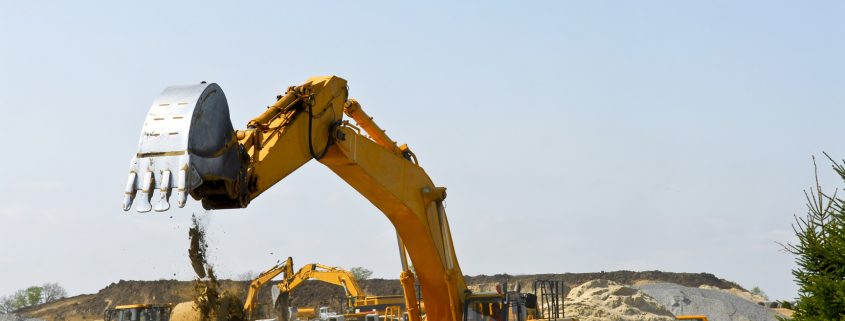Canadian Oil Sands Innovation Alliance sees benefits of floating equipment.
http://www.cosia.ca/initiatives/land/amphibious-vehicles
Evaluating amphibious vehicles for year-round restoration
Changing the game for boreal forest caribou habitat restoration
Introduction
COSIA member companies are working hard to protect caribou in northern Alberta by restoring their habitat, however much of the land is muskeg, a swamp-like boreal environment that’s wet, peaty and difficult to reach. This creates huge challenges because the heavy machinery used for restoration can get stuck in the terrain. Until now, work has been limited to a two-month period in winter when the ground is frozen, allowing equipment access. That’s where amphibious vehicles—machines that can drive on land and float on water—come in. Using these vehicles for caribou habitat restoration is a first, and may be a game-changer in improving the pace and cost of restoration with minimal environmental impact.
Industrial activities over the past several decades have fragmented the boreal forest as corridors were cut to accommodate forestry and oil and gas activity, including seismic exploration and winter access routes for exploration drilling. These corridors allow deer and moose as well as their predators—primarily wolves—to move more easily into caribou habitat. A common obstacle to restoring this land is that it’s often inaccessible because the ground—muskeg—is too spongy and wet. Conventional equipment sinks in these conditions so can only be used in winter, when the ground is frozen.
This project explores using extremely low ground-pressure, and amphibious equipment to perform caribou habitat restoration activities in the muskeg of northern Alberta when the land is not frozen, and where conventional equipment can’t access the wet areas. Amphibious vehicles can operate on dry land, muskeg and even water. Equipped with an extra-large undercarriage filled with air, the vehicles are similar to pontoons and can safely navigate the deep peat and marshy or swampy terrain of boreal forest at any time of the year.
The project builds on an earlier joint industry project (JIP) carried out by Cenovus and partners ConocoPhillips Canada and Devon, which reviewed potential existing equipment and performed a site test of multiple candidate vehicles to assess the potential benefits of using this type of equipment.
Cenovus and partners ConocoPhillips Canada, Devon and Nexen are now further evaluating the use of amphibious equipment as well as other alternative restoration equipment types and methods through a large scale operational trial. Within this trial, JIP participants will evaluate the use of a tree spade on an amphibious trackhoe to transplant trees and plants from native forest onto the areas being restored. It is hoped that this will dramatically speed up the return to forest cover and restore habitat more quickly. Also being evaluated in this trial are implements that can be dragged across the soil surface to create surface roughness in order to increase survival of planted trees and encourage natural regeneration of trees and shrubs. If successful, these dragged implements may be much faster than the current soil mounding techniques being utilized. This trial will be completed in the fall of 2016.
Environmental Benefits
There are four benefits to using amphibious vehicles for oil sands restoration.
- Amphibious vehicles compress the soil very little and are much less likely to leave ruts or get stuck in the muskeg because of their low-pressure footprint.
- “In November 2015, we successfully tested two amphibious vehicles with modified tracks and an air-filled undercarriage that allow them to safely navigate the muskeg even when it’s not frozen,” said Ted Johnson, Group Lead of Land and Biodiversity at Cenovus Energy. “We found the vehicles were able to do restoration work on soft soil and cross a creek without causing damage or stirring up sediment in the water.”
Amphibious vehicles may have the ability to restore more than twice the land area per day compared to standard machines, and can potentially greatly extend the traditional midwinter operating season.
Amphibious vehicles may improve restoration success. In the traditional two-month winter work period, the effectiveness of restoration treatments like mounding and stem bending is reduced by hard frozen ground. Additionally, survival rates of live transplanted and planted trees may be lower in winter. - “We’ve executed this type of restoration work over four successive winters from 2010 – 2014,” said Jeremy Reid, Environmental Professional at Devon Canada. “Operating intensive restoration programs in extremely remote areas during winter is a major limitation on these programs. I can definitively state that if the goals of this study are achieved, it is a game-changer for caribou habitat restoration.”
- Improved linear disturbance restoration may help reduce use of these corridors by predators and prey. Restoration of these features may ultimately reduce caribou predation.“Some of the restoration work we’ve completed using these amphibious vehicles includes mounding the ground to make high, dry areas for seedlings to take root and bending tree stems to make it harder for caribou predators like wolves to navigate old seismic lines,” said Ted. “These vehicles have the potential to do restoration work in any season, at a faster pace, a lower cost and with minimal environmental impact.”
By enabling a longer operating season with reduced impacts and increased success, the end result of restoring caribou habitat could be realized sooner.
Collaboration
The 2015 Amphibious Vehicles Project was led by Cenovus Energy with contributions from Devon and ConocoPhillips Canada.
The 2016 Evaluation of Alternative Restoration Equipment project is led by Cenovus Energy with contributions from Devon, ConocoPhillips Canada and Nexen Energy.

